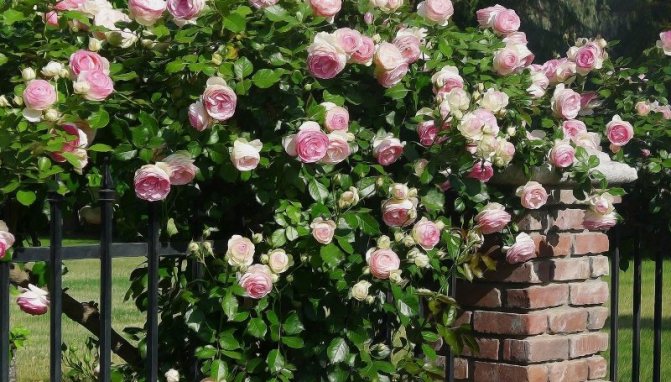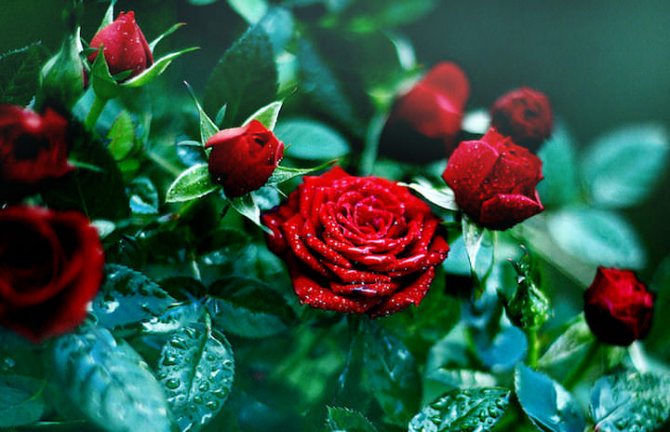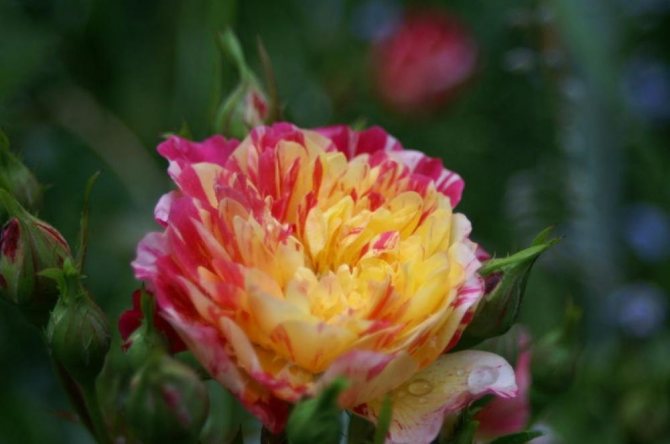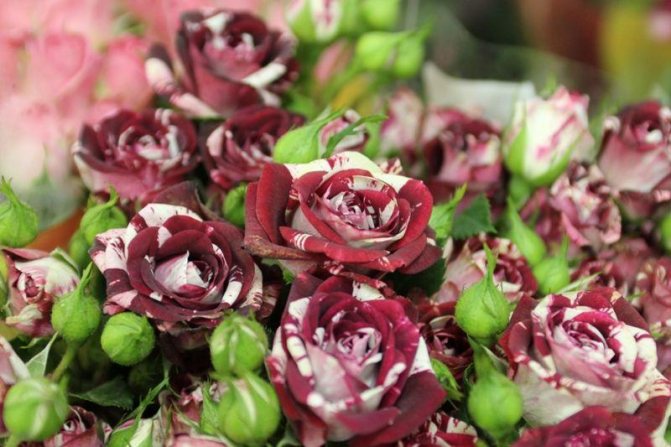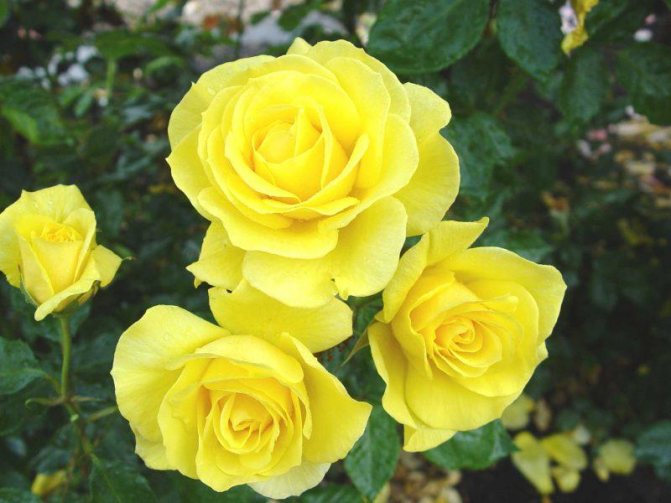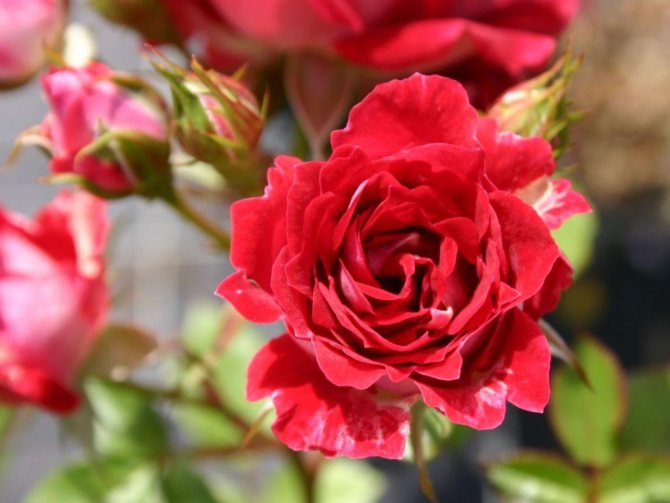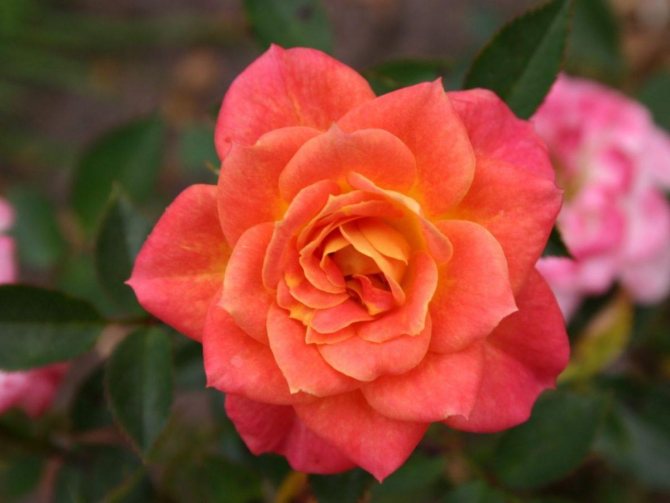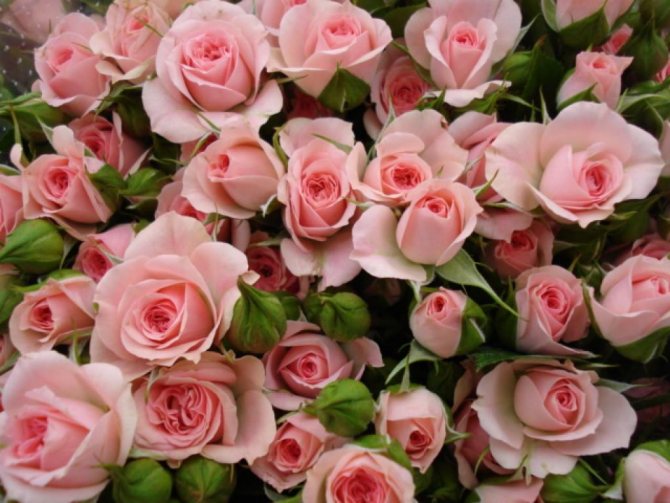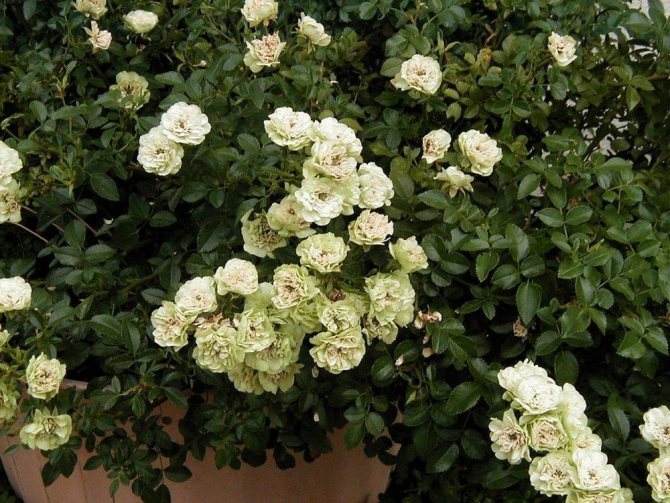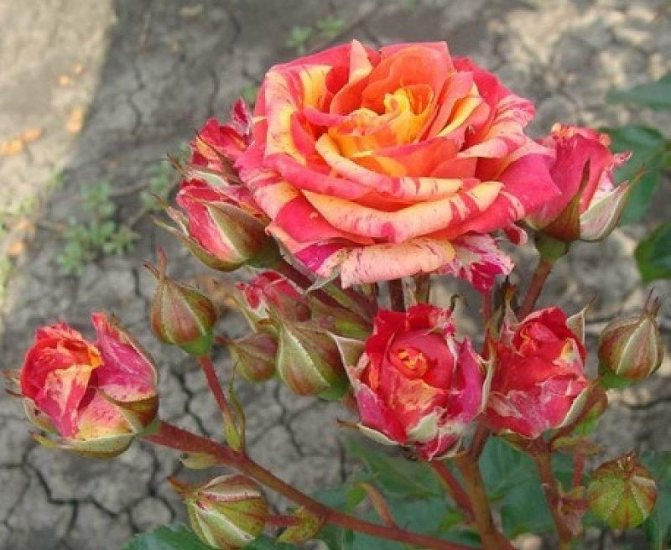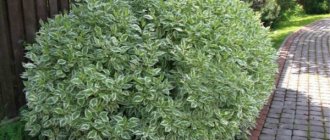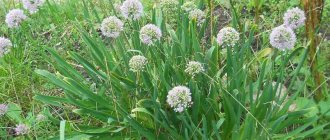Roses are one of the most popular and famous decorative flowering plants. They began to be cultivated since the time of Ancient Rome, today several hundred species and varieties are known. Among all varieties, bush roses intended for growing in a garden or greenhouse are widespread.
They are used for landscaping areas, flower beds and urban plantings. This is the largest group of roses and includes flowers of a wide variety of shapes, colors and heights. In the article you will find the most famous varieties of spray roses, their descriptions and photos.
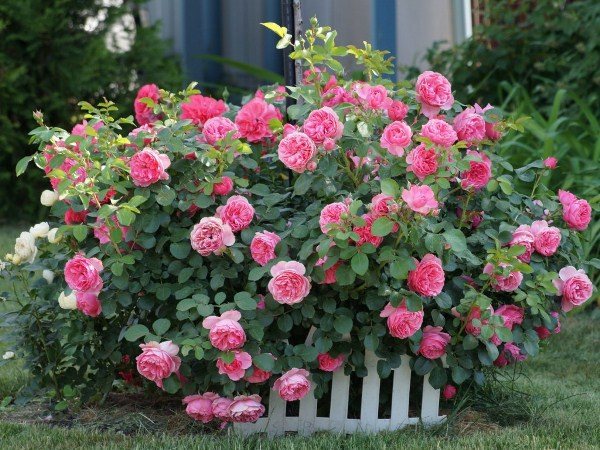
Features of spray roses
Bushes of this type of rose can have a very different shape, directly depending on the variety - from spreading to narrow pyramidal. Also, the height of the bush depends on the type and variety, which can vary from 25 to 300 centimeters (and even more). The branches of the bushes of such plants are divided into 2 types, namely, annual stems and uterine (main) stems. Unpaired leaf plates have elliptical or ovoid leaflets with a serrated edge. They also have 2 leaf-like stipules.


The peduncle of such plants can be 10–80 centimeters long, with the diameter of the flowers varying from 2 to 18 centimeters. The incredibly beautiful rose flowers can have a wide variety of shapes and colors. Flowers, as a rule, consist of 5-120 petals. There are both single flowers and those that are part of inflorescences (3–200 pieces). In shape, flowers are distinguished pompom, cone-shaped, saucer-shaped, peony-shaped, cup-shaped, flat, spherical and others. The color of roses can be very different, so today there are no flowers only of deep blue color. Thanks to the labors of breeders, a huge variety of varieties and hybrids of roses appeared, which can be painted in a variety of color shades and their combinations, while the "list" is constantly growing. Of course, the blossoming rose flowers are an amazing sight. And even the most sophisticated connoisseur of beauty can be delighted with roses, which change their color during flowering. Also, these flowers are distinguished by a wide variety of aromas.
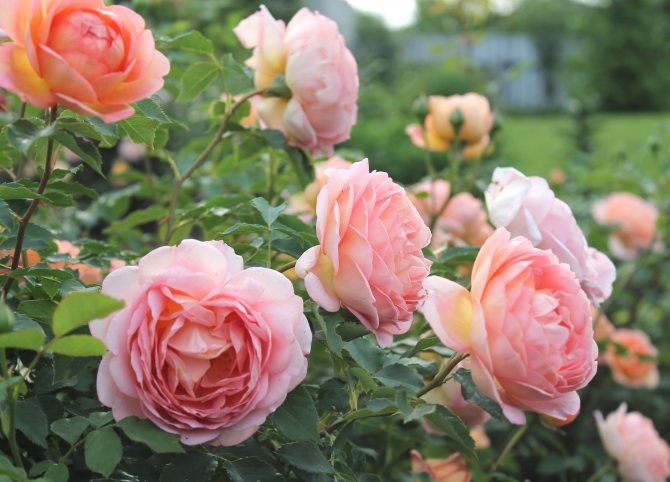

Polyanthus
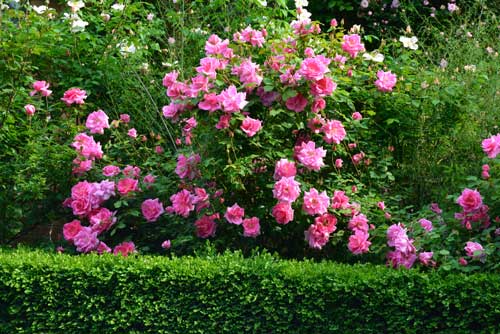

They were bred in France in 1873. These are multi-flowered roses, which, according to modern classification, are classified as bush roses. The plant is usually short (40-60 cm), but it has very dense foliage and small flowers. During flowering, they completely cover the plant; up to 50 flowers can form on one inflorescence.
They have high indicators of frost resistance and vitality. Most varieties are resistant to fungal infections. Polyanthus roses are easy to grow from seeds; in adulthood, the shrub is not afraid of shade and drought. The flowers are suitable for decorating a plot or using in bouquets Popular varieties:
- The Snow Queen... Cultivated since 1901. The height of the bush reaches 1 m, the shoots grow straight. The buds are pinkish at first, and become bright white as they bloom. Flowers are odorless. The main disadvantage of the variety is its low resistance to powdery mildew;
- Alfred Colomb... The variety is represented by a vigorous bush, on which large double buds are formed in large numbers during flowering. The flowers are strawberry colored;
- Goldstein... The branchy bush reaches 80 cm in height. The leaves are very large and leathery.Cup-shaped buds during flowering cover the entire bush, thinning the pleasant aroma. The petals are colored dark crimson.
The modern division of all garden roses was only approved in 1976. Due to the similarity with hybrid tea varieties, some polyanthus varieties can belong to two groups at the same time.
Landing
Before planting, if there is such a need, you should prepare the soil. Shrub rose loves slightly acidic soil that can easily wick moisture away and breathe. These are the unassuming requirements inherent in bush roses of most varieties.
The correct fit looks like this:
Loading ...
- The roots of the seedlings are shortened with a garden knife. In this case, you need to pay attention to dry processes and remove them;
- Cut off the stems, leaving cuttings, no more than 20 centimeters in length;
- Prepared seedlings are soaked in settled water at ambient temperature;
- A landing hole is prepared. For most varieties, 40 centimeters in diameter and depth are sufficient, 10 centimeters longer than the root;
- Planting soil is being prepared. For this, compost is added to the removed soil in proportions of 1/3 and mixed with a glass of ground charcoal;
- The bottom of the landing pit is loosened and poured with a bucket of water, having previously dissolved a heteroauxin tablet in it.
After these procedures, you can plant the seedling in a hole, sprinkle with prepared soil and tamp. Be sure to make sure that the root nodule is at ground level, and the seedling is located vertically. After carefully compacting the soil, an earthen roller should be organized around the cutting, which will hold the irrigation water, and around the stem, the soil should be burnt, about 10 centimeters high.
Despite the love of roses for light, in the first couple of weeks after planting, seedlings should be grown in partial shade, and the first watering after planting should be no earlier than a couple of days.
Another planting method is to grow a rose from a container. Before planting, the container is watered abundantly and placed in a hole fertilized with compost, after which the container is carefully removed, and the resulting gaps are filled with soil and rammed. Further actions are completely similar to those described above.
Important! Shrub roses, depending on their variety, require a certain spacing between shrubs when grown - from a meter to two, and sometimes more. If this is not taken into account, growing, the plants will only interfere with each other, and this will lead to a decrease in their decorative effect. Among other things, such bushes will not live for the years they are supposed to.
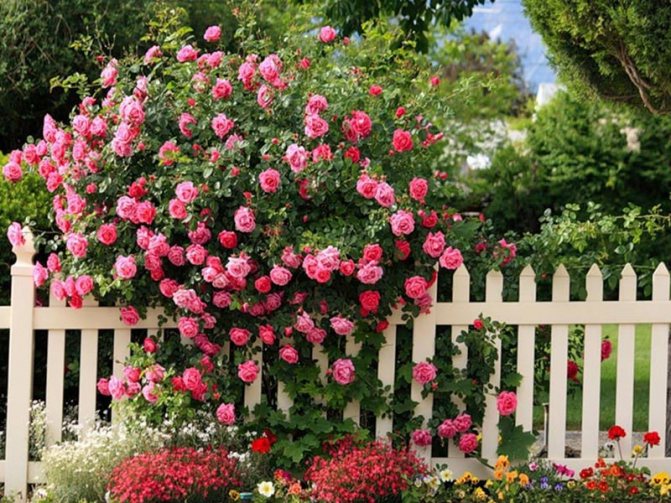

Features of planting bush roses in the Moscow region, Siberia, in the Urals
The difficult and harsh climate of the northern regions is not able to withstand all roses. In this case, the main thing is to choose the right variety: Rosarium Uetersen, New Dawn, Golden Celebration, William Shakespeare 2000, Westerland.
Suitable for the Moscow region: Irish Eustoma (Estoma), Ruscus, Charles Austin, Alexander Kent, Crown Princess Margareta, Rose Claire Austin.
In the spring they are planted at a soil temperature of +8 to +10 degrees, around the end of April, and in the fall - at +4 degrees of air. But experts recommend keeping the seedlings until spring. The site should be elevated, located on the south side and protected from drafts.
If the climate of the region is very capricious, it is better to consult a specialist before choosing a variety for a garden.
Bush rose varieties
It is noteworthy that today there is no single classification of bush rose varieties in the world. On the territory of the post-Soviet space, the most common types of spray roses that bloom in red, white, yellow or two-color flowers. Read more below.
Shrub roses. Variety names:
- english... In favorable conditions, bush roses of this variety form a dense, spreading bush with many leaves and inflorescences.In height, English bush roses can reach one and a half meters. The flowering period is quite long - it lasts more than a month, starting in June. The color palette is quite calm: most often you can find white-purple flowers, less often yellow or orange ones. The undoubted plus of this variety is its high frost resistance, the bushes of this plant can not be wrapped up for wintering;
- piano ed... This variety is notable for its bright floral palette. The shrub rose of the Piano Red variety blooms with bright blood-red flowers. The plant of this species is quite compact with a branched structure and many leaves. Flowers are small, peony, spherical. A shrub rose of the piano red variety grows up to a meter in height and has large, shiny bright green foliage;
- red lex... This variety is very similar to the one described above. It blooms with deep red cupped flowers with velvety petals. The bushes reach no more than 65 centimeters in height and have erect shoots. It is better to plant a plant of this variety in a group, so it looks more attractive and impressive;
- porcellino... Porcellino is a creamy white spray roses with classic buds. The aroma of this type of bush rose resembles the smell of vanilla, very light and unobtrusive. The leaves do not grow very densely and have a pale green tint. The bush of medium growth rate reaches a height of no more than 80 centimeters;
- bomber... A fairly common variety of bush rose that blooms pink. In general, the bombastic is a Dutch rose, peony-shaped. The bombastic shoots are very strong, erect. Growth vigor - medium, no more than 65 centimeters in height;
- freesia... Another popular variety of spray roses is freesia. The flowers of this plant species have a bright yellow color. The bushes are quite compact with dark green foliage. It is noteworthy that freesia bushes have a very high resistance to diseases;
- iguana... The plant of this variety has very beautiful flowers of a reddish-copper color with a velvety structure. Classic buds. The bushes have a small foliage, the vigor of growth is average - up to 65 centimeters in height.
- calypso... The flowers of this variety of bush rose have a very interesting color: the petals are bright crimson with pink stripes. The aroma of the flowers is quite light, unobtrusive, with a characteristic floral note. The foliage is large enough, bright green. Bushes are tall, up to two meters in height. Shoots do not have thorns.
Grandiflora
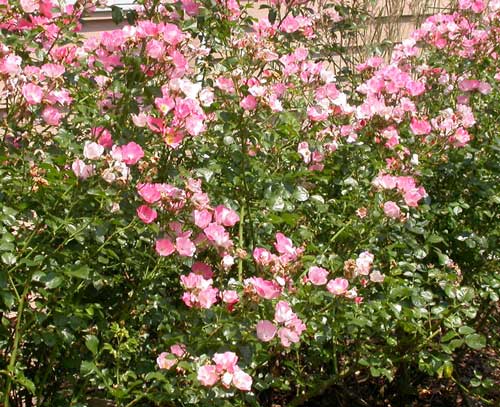

One of the youngest groups of garden bush roses, eaten away in the 50s of the last century by crossing hybrid tea varieties with floribunda. The bushes are distinguished by a strong structure, can reach a height of up to 200 cm. The flowers are shaped like a hybrid tea rose, but have a more lush structure.
They are used for decorative gardening of areas, they look beautiful both in single and group plantings. They have a high immunity to diseases, some varieties are frost-resistant. The most popular varieties:
- Stella... Erect bush, forms long shoots with large thorns. The buds reach a diameter of up to 12 cm, collected from 30-40 petals. The flowers are peach-pink in color, exuding a pleasant aroma during flowering. Suitable for growing as a standard crop and cut;
- Sonya... It is represented by an erect shrub up to 80 cm in height. The buds are collected in small clusters of 3-5 pieces. The flowers are colored in a coral shade and have a fragrant smell. Very long flowering, suitable for creating bouquets;
- Love... A vigorous plant that grows up to 80 cm. It is used for group and single plantings. Blooming is unnatural for this group of roses - inside the petals are red, outside they are covered with a silvery-white bloom. Goblet buds reach 13 cm in diameter. The variety is frost-resistant, can withstand darkening;
- Komsomolsky light... A shrub rose variety, it grows up to 120 cm in height. Shoots are erect, they have large matte leaves. Cup-shaped buds reach 13 cm in diameter, collected from 20-25 red petals with a golden tint inside. Has high frost resistance, suitable for group planting.
According to the modern classification of roses, more than 30 groups of these plants are distinguished. They are united by the height of the bush, the shape and structure of the buds and the specifics of growing. Shrub roses are considered one of the most popular varieties of this culture. With the help of them, you can decorate a plot or a flower bed, flowers look decorative and in a cut. When choosing a variety, one should take into account the resistance, frost resistance, appearance and features of the formation of the bush.
Watering garden roses
Also important factors in plant care are regular watering, top dressing, loosening and weeding of the soil. It is recommended to supply moisture not very often (when the soil on the site dries out), but abundantly. Newly planted bushes are an exception: they should be watered every other day. The rate of water for each adult plant is 10 liters; depending on the season, this figure may vary. So, in a hot and dry summer, roses need to be watered more often and more. The supply of moisture should be done in moderation, not intensively, so as not to wash off the soil from the roots; do not use too cold water. The optimal time for watering is in the morning and evening hours, and the drip method is considered to be the most recommended method of supplying moisture to the plants. At the end of summer, at the end of flowering, in order to prevent stagnation of water in the soil, the irrigation rate must be reduced. Otherwise, there is a high risk of developing fungal infections for a plant such as a garden rose. Growing such a culture in the garden is a real holiday, allowing you to enjoy beautiful natural creation every day.
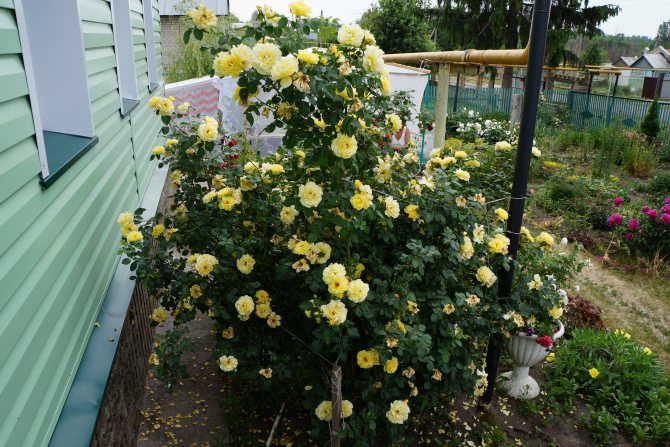

Conditions of detention
- A place... Indoor rose loves free space, so it is worth placing it so that it does not come into contact with leaves with other plants. It would be best to put a bush rose on or next to the south window.
The rose needs constant access to fresh air, but at the same time it is necessary to avoid the formation of drafts. - Temperature... The rose is thermophilic, but sensitive to an excessively hot climate, therefore, the optimum temperature during growth and flowering will be +14 .. + 25 ° С. During the rest period, the temperature in the room with the rose should not exceed +5 .. + 8 ° С.
- Humidity... It is important to provide sufficient moisture not only for the soil, but also for the air for the rose. To do this, 2-3 times a week, and in hot dry weather every day, the leaves are sprayed with warm, settled water. Sprinkler irrigation is reduced during sleep.
- Lighting... The plant needs a lot of sunlight, which is why it is recommended to place it on a south window or balcony. With increased solar activity, you can shade the plant to avoid leaf burns, but do not abuse it.


Watering... A growing and blooming rose is watered often, daily or every other day, especially in the hot season. It is best to water it in small portions, since the rose is very sensitive to excess moisture. It is necessary to ensure that excess moisture does not accumulate in the pallet and remove it immediately. Water the bush rose with warm, settled water in the evening. At rest, the flower is watered very rarely, only to prevent the root system from drying out.- Top dressing... During active growth, you can feed the plant every 2 weeks using special additives designed for indoor shrub roses. During rest, the rose is fertilized once a month.
- Pruning... Pruning is carried out when preparing the rose for the "sleep" period. To do this, remove all weak and dried branches, shorten each shoot, leaving 5-6 buds.If you do not prune, over time, the shoots will stretch out, look sloppy, and the flowering will become poorer.
- Transfer... Transplanting is another procedure in preparing a rose for wintering and is carried out annually after pruning. The pot into which the plant is moved should be 2 cm larger in diameter and 5-6 cm higher than the previous one. The rose is transplanted together with an earthen clod from an old pot, as in the first planting.
- Prevention of pests and diseases... To prevent the onset of indoor rose diseases, it is necessary to carefully take care of the microclimate conditions necessary for this plant. Most rose diseases result from improper care.
Feeding activities
For active development and abundant flowering, garden roses need to be fed. In the first year of planting, this process can be skipped, since the required fertilizers have already been placed in the planting pit. Starting from the second season, feeding must be done: at the beginning of the growing season, during the formation of buds, at the end of flowering and before the process of lignification of the stems.
After the spring pruning of the bushes, twice, with a week break, 20 g of ammonium nitrate or ammonium sulfate is applied for each square meter of the area. During the formation of buds and after flowering, 30 g of superphosphate, 20-30 g of ammonium nitrate and 10 g of potassium salt should be added to the same area. In August - September, superphosphate and potash salt are introduced into the soil: 30-40 g per square meter. Of organic fertilizers, which should be alternated with mineral fertilizers, it is better to use wood ash and slurry in the rose garden.
Reproduction
The easiest way to propagate a bush indoor rose is by cuttings. For this:
- A branch with a formed bud is chosen and a stalk 15-30 cm long is cut off. The cut angle should be minimal.
- Excess leaves and flowers are removed from the branch.
- Sections of the cuttings and the mother bush are treated with a solution of potassium permanganate,
- Then the cut off shoot is soaked in a root solution for 24 hours.
- The cutting is planted in prepared loose soil, deepening so that the upper bud is above the ground.
- Water and spray the plant daily, but not too abundantly.
- To create a greenhouse effect, the sprout is covered with a dome. It is made from the cut off top of the bottle with the cap off to allow air to flow. The dome is removed with the appearance of the first leaves.
How to transplant a plant correctly
A garden rose, planting and caring for which in the open field requires certain knowledge and skills, tends to grow, and therefore the bush loses its decorative effect. Therefore, sometimes the plants have to be transplanted. The best time for such an action is October or April. Before transplanting, it is advisable to cut the garden bush rose by 20 cm, then you need to cut off all the leaves and remove the damaged branches. The plant needs to be dug out with an earthen lump and carefully transferred to a new hole, previously filled with water.
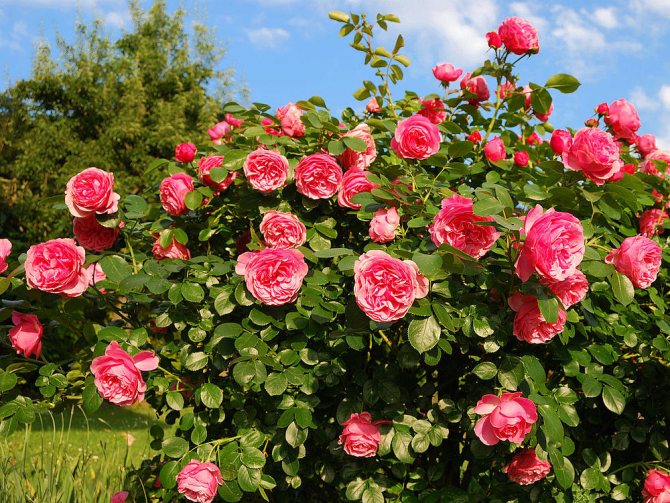

Features of agricultural technology
Before you start cultivating roses, you need to get to know the requirements of this elegant queen. In addition, you will have to come to terms with the thorns, which are strewn with bush roses.
Advice! Growing roses is greatly facilitated if varieties are initially selected that are adapted to the climatic conditions of the area. This will ensure good survival, quality development and generous flowering.
But even the most hardy varieties will need shelter for the winter, forming and sanitary pruning, timely feeding and traditional grooming activities. Let's talk about the intricacies of landing.
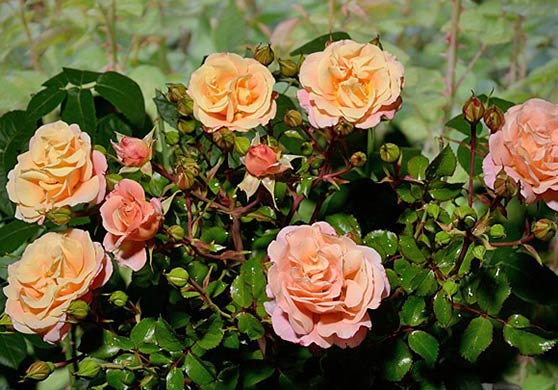

Features of the pruning
The most difficult part of caring for garden roses is pruning, which activates the development of shoots and rich flowering.This procedure is carried out from spring to autumn and has a different purpose. In spring pruning, the plant is freed from dried and old shoots with a parallel bush formation. The summer procedure is considered sanitary: a larger specimen is left from several flower buds. It is also required to remove wilted flowers and set fruits. In the fall, the plant prepares for future wintering: damaged and dried shoots are cut out.
How to properly prune a gorgeous plant like a garden rose? Planting and leaving in spring is less frightening for an inexperienced grower than pruning a plant. There is nothing complicated in this procedure, it is only important to know some of its subtleties in order to safely handle the plant in the future.
What should be discarded when caring for a home rose?
Cold water. For watering a bush rose at home, you can use only settled water at room temperature. Are there small pests? Urgently open a home first aid kit for the care of home potted flowers.
Did the rose start to wither or grow poorly during the growing season? It is worth understanding the situation - perhaps the plant is sick and cannot cope without human help. Careless attitude to the root system of the flower (the reason may be, for example, the frequent wandering of a rose from one pot to another).
Dry air, rare watering and direct sunlight at high temperatures outside are harmful to such a flower. Rose is a noble and grateful plant to its owner. The average flowering time (depending on the variety and some factors) is from a month to six months. The average growth that domesticated roses reach is half a meter in height (excluding the root system).
Autumn planting
When planting a bush rose in autumn, it is necessary to start preparing for this procedure 8 weeks in advance. In the event that the groundwater comes too close to the soil surface, then it is imperative to build a raised flower bed for roses. Otherwise, the root system of the plant will be almost constantly damp, and from this rot may appear on it, the bushes themselves will look unhealthy. Remember that the soil in the garden is ideal only in isolated cases, in this regard, it needs to be "corrected" so that it becomes suitable for growing a bush rose. Remember that how beautiful the bush you grow will be directly dependent on the composition of the soil. During the digging of the soil, fertilizers and humus should be added to it. So, per 1 m2 of the plot, a full ten-liter bucket of peat and garden compost (manure) is taken, a couple of glasses of wood ash and bone meal, as well as from 30 to 50 grams of superphosphate. In excessively clayey soil, sand must be added (1 or 2 buckets per 1 m2). During planting, you must follow the rules described above. Bushes planted in autumn must be completely covered with soil for wintering.
When and how to plant roses
The first half of autumn is considered the best planting time. It is during this period that strong viable seedlings come from nurseries.
Important! The purchased seedlings are carefully examined, broken or rotten roots are removed, and a moist environment for short-term storage is provided. A good purchase option is a containerized plant (with a protected root system).
Rosa is a lover of open spaces, bright sun and sublime places. Optimal for it are areas without a close approach of groundwater with fertile, water- and air-permeable weakly acidic soil (pH 6-6.5).
Landing technology
Before planting a rose, the stems should be shortened to 15-20 cm, and the roots should be immersed in water for several hours. Digging a planting hole, they are guided by the vaccination site - a characteristic thickening. It deepens when planting by 5 cm. The diameter of the hole is 40-50 cm. High-quality humus or compost (one third of the volume of the earth) is added to the excavated soil, a glass of ash is added and mixed.
A bucket of water is poured into the pit with the addition of aloe or heteroauxin juice, a seedling is placed and gradually sprinkled with prepared soil.
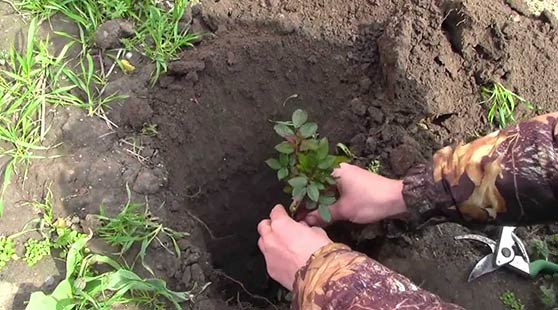

Important! To avoid the appearance of air pockets that have a detrimental effect on the roots, the seedling is periodically shaken during planting, and the earth is compacted.
When the planting of roses is finished, the plant is spud high, then watered again. Plants are planted with an interval of 1-1.5 m, focusing on the variety. For better rooting, the seedling is watered moderately every 2-3 days. When the first shoots appear, the soil with which the plant was spud is raked off, and the soil is mulched with chips or humus. Autumn plantings for the winter are completely covered with soil.
The best period for planting roses in spring is from late April to late May.
Planting a rose in spring
In the event that the winter period is characterized by severe frosts, then the planting of a rose seedling can be done in the spring. This is done from mid-April to the second half of May, it is necessary that the soil be warmed up to 10 degrees. It is recommended to prepare the above pit preparation at least 4 weeks before disembarkation. It is necessary to trim too long roots and completely remove those that have dried up, as well as diseased ones. It is necessary to cut the stems so that they are 10 to 15 centimeters high and have at least 2–4 buds. In the case when the planting material has been stored for a long time, and its roots have dried up quite a bit, it is necessary to lower them into the water a day before planting, and immediately before planting, immerse them in a clay-dung chatterbox.
A small part of the prepared soil should be poured into the hole with a slide (see above for how to do this). Then you need to put a seedling in it and hold it by the shoot with one hand, with the other you need to gradually pour the soil into the hole, not forgetting to constantly tamp it. Remember that the grafting site should be at a depth of 3 to 5 centimeters. When the seedling is planted, it should be well watered, and when the water is absorbed, then spud. After the first shoots appear, the soil that was used for hilling the bush must be removed. In this case, the surface of the soil around the bush should be sprinkled with a layer of mulch (humus or peat), the height of which should be about 5-8 centimeters. Pine bark or wood chips should be used as mulch for areas with non-renovated roses.
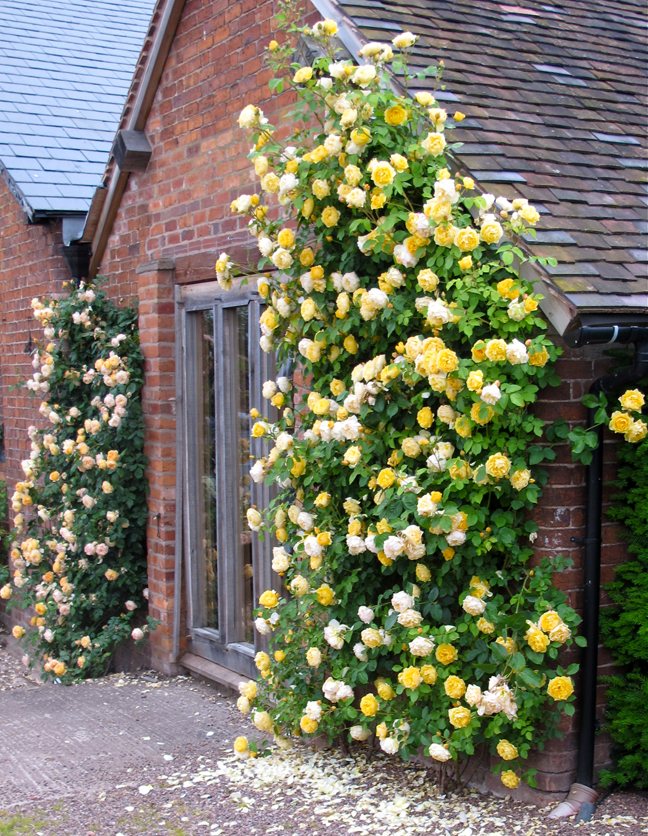

Breeding technology
It is possible to independently plant bush roses in a personal plot or in a garden in several quite affordable ways. Shrub roses can be propagated by seeds and vegetatively, but the second option is preferable.
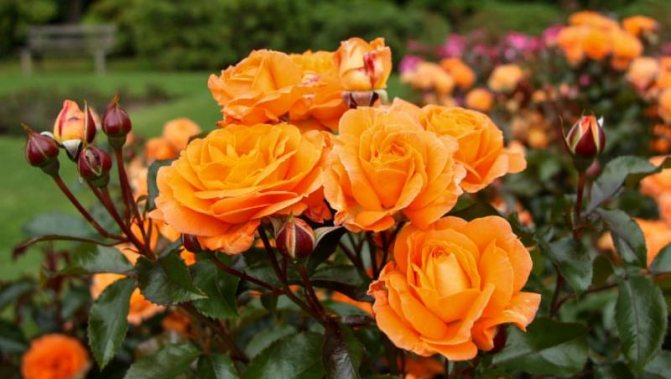

Vegetative propagation of rose bushes is most often carried out by cuttings, subject to the following rules:
- cuttings should be cut from flowering shoots, the thickness of which should be 0.5 cm;
- a high-quality cutting suitable for rooting must have at least three internodes;
- the lower oblique cut must be treated with growth stimulants, and then immersed in a container with water;
- after a couple of weeks, subject to the optimal temperature regime, a callus forms on the handle, gradually turning into a light influx;
- the formation of callus indicates the readiness of the planting material for transplantation into a nutritious soil substrate;
- The soil mixture is considered optimal for rooting, consisting of humus, peat, coarse sand and sod soil, mixed in a ratio of 0.5; 1: 1: 1.
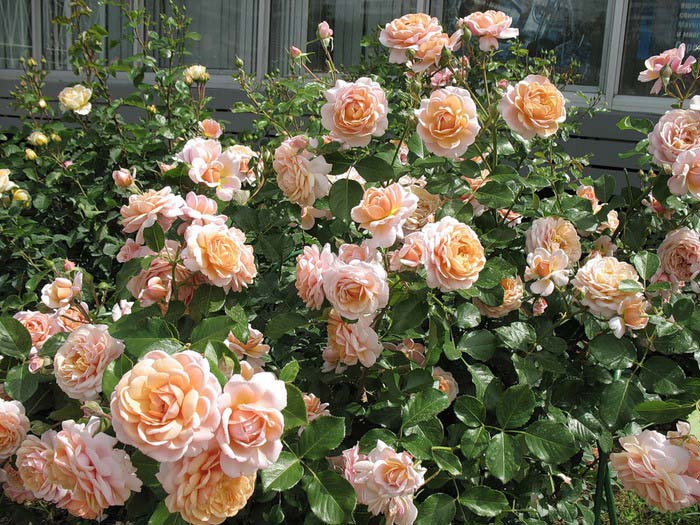

Subject to the germination technology, after about ten days, buds germinate on the planting material, start growing. Rooted cuttings should be planted in early spring, after the threat of damage to young plants by recurrent spring frosts has completely passed.
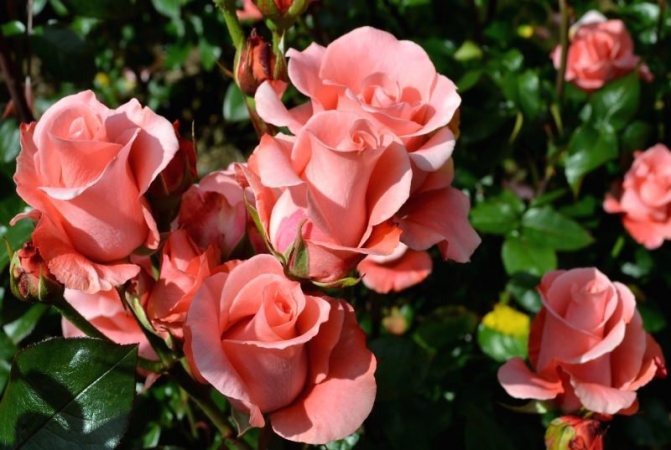

The vaccination method has also worked well.It is recommended to plant bush roses on young rose hips or a dog rose, which have high winter hardiness and a powerful root system. The stock can also be represented by small-flowered, wrinkled, cinnamon and loose roses. Inoculation by budding should be done in mid-July.
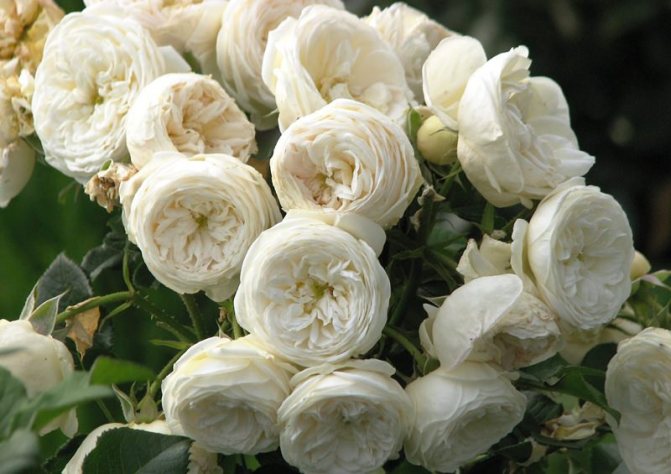

Reproduction of bush roses
All types of roses can be propagated in four ways - by cuttings, offspring, layering or dividing the bush. The simplest and at the same time effective way is grafting. We will talk about him.
Cuttings for planting are harvested at the beginning of flowering. Cuttings are selected in areas where complete woodiness has not come, but absolutely young, green shoots are not suitable. The cutting should be about 10 centimeters long and about 5 millimeters thick.
The stalk is cut so that its lower cut passes under the kidney, and the upper one, slightly above the kidney. Moreover, at the top, the stalk is cut at a right angle, and at the bottom at 45 °.
Cuttings prepared in this way are deprived of thorns and foliage in the lower part, treated with phytohormones and planted in a slightly shaded place in sandy soil at intervals of at least 15 centimeters. After that, the cuttings are watered and a kind of greenhouse is arranged over them - they are covered with polyethylene stretched over a frame.
To ensure ventilation, it is advisable to provide vents in the greenhouse, at worst, the film will need to be regularly temporarily lifted.
In such conditions, cuttings develop all summer and autumn, and before winter they need to be insulated and covered with garden film. In this position, they easily overwinter. The next year, upon reaching warm weather, the film is removed by the end of summer, and with the first cold snap, the cuttings are again covered with film and insulated before winter.
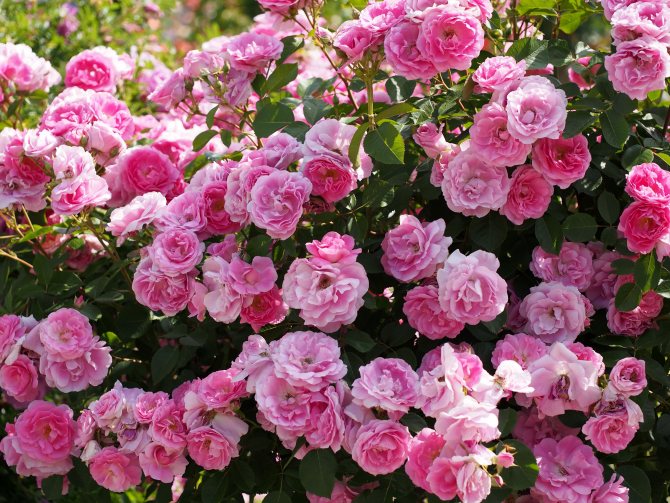

Pros and cons of growing an indoor flower
Growing this plant in an apartment has a large number of positive aspects.:
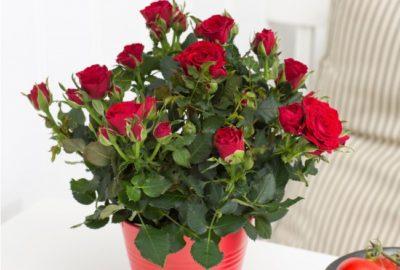

Year-round flowering. With proper care, you can enjoy rosebuds in both winter and summer. It must be remembered that some varieties require a short rest between flowering.- Compact size. The convenient dimensions of the plant itself and its root system allow you to keep the rose in a small pot on the windowsill.
- Since the bush rose is one of the varieties of garden roses, if desired, it can be transplanted to a site where it will continue to delight the eyes of others.
But there is also disadvantages to be aware of before purchasing a room rose:
- Difficulty in leaving... The plant is quite whimsical and sensitive to excess or lack of sunlight, moisture, temperature changes. Requires careful care and attention.
- Need for "sleep"... Some varieties of spray roses need to take breaks between flowering, during which the plant must be kept in special conditions.
- Little or no aroma... Unlike the fragrant garden siblings, the scent of most indoor rose varieties is faint and almost subtle.
Diseases of roses
If roses grow in unfavorable conditions, they weaken, their resistance to disease decreases, and they can be exposed to pests. Among the diseases that affect weakened rose bushes, most often you have to deal with powdery mildew, downy mildew (peronosporosis), rust, marson's roses (black spot), chlorosis. If fungal diseases of roses can be cured with fungicides - a three percent solution of copper sulfate, a one percent suspension of colloidal sulfur, then chlorosis, from which the rose turns yellow, develops as a result of a lack of certain elements in the soil, and primarily iron. You will have to do a soil analysis, finding out, due to the deficiency of which element, the leaves of the rose turn yellow, and eliminate the cause by adding salts of the missing nutrient in the recommended doses to the soil.
Pest and disease control of bush rose
It is necessary to start the fight against pests and diseases of the bush rose with preventive measures that are carried out throughout the year.
These include weeding and pruning of bush roses, their timely and sufficient watering, making the necessary dressing, as well as proper preparation for winter.
Of the diseases, the greatest danger to bush roses is represented by fungal diseases. To avoid them, you should choose a planting site without high humidity, with high groundwater, without drafts, not darkened.
If the fungal disease still managed to infect a bush rose, then rotted shoots and roots should be removed by transplanting the rose to a more suitable place. Also, during winter storage of seedlings in unventilated and damp rooms, there is a high probability of developing fungal diseases.
If the rules for sanitary pruning of a bush rose are not followed, the probability of its death is high. Therefore, before spraying with chemicals for diseases, branches, buds and leaves already infected with the disease should be removed in a timely manner. This will help prevent further contamination of healthy parts of the plant and nearby bushes.
The defeat of the leaves of a bush rose with rust
Bush rose diseases should also include black spot, powdery and downy mildew, anthracnose, gray mold, rust, cercospora. In the fight against these and other diseases, various drugs will be effective, including fungicides that are optimal for the local climate and are recommended by flower growers.
In the fight against pests, it is important to control their appearance on a bush rose and timely countermeasures.
The most common pest is aphids... With its small colonies, aphids are washed off with soapy water. With a large spread of aphids, it is recommended to use insecticides and special preparations.
Bush rose pests are gnawing pests such as beetles and caterpillars, as well as sawer larvae. Spider mites and cicadas can also do a lot of damage to a bush rose.
Rose pests
Insects that damage the flowers, leaves and stems of a rose can be divided into sucking ones, which include aphids, ticks, scale insects, cicadas, or rose whiteflies, and gnawing ones, represented by beetles, sawfly larvae and caterpillars. Sucking pests pierce the tissues of the ground parts of the plant and feed on their cell sap, which causes disruption of physiological processes and leads to twisting and falling of leaves, the death of shoots. Gnawing pests violate the integrity of the organs of the rose, and this leads to the fact that the growth and development of the plant slows down, the flowering becomes not so abundant, and the rose loses its decorative effect.
You can fight pests as they appear, but in order to avoid a harmful invasion of insects, it is enough to carry out the spring preventive treatment of rose bushes until the buds swell with insecticides such as actellic, karbofos, rogor or spray the plants with a solution consisting of 2 g of kerosene diluted in 10 l of water. In the fall, after pruning the bushes, rake and destroy all plant residues and fallen leaves and treat the bushes and soil under them with the same preparations in case the pests have settled down for the winter in the soil under the bushes or in cracks in the bark.
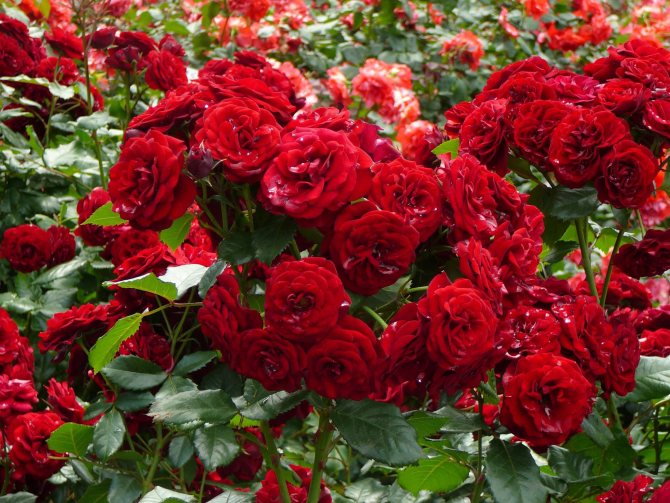

Small-flowered variety roses.
Climbing small-flowered roses (until the last classification, this group of roses was called rambler - Rambler) includes the so-called "curly" roses with long, flexible, creeping or arched shoots (lashes) that require support.
The varieties of these groups have small flowers (2-3 cm in diameter), double and non-double, weak-minded, collected in large openwork inflorescences, mostly pink, crimson-red and white.
Leaves, consisting of 7-9 leaflets, small, hard, shiny. The thorns are large, curved. Bushes with long recumbent or creeping, fast-growing shoots up to 5 m long.Roses bloom once, but for a long time, for 30-35 days along the entire length of overwintered shoots (shoots last year), usually from late June to August. Therefore, annual shoots are not pruned for the winter and they try to keep them to their full length (see the section "Pruning"). The fruits are small, dark red. For 1 sq. m planted from 1 to 2 bushes. The origin of climbing small-flowered roses is associated with wild species: with the multiflora rose (R. multiflora) and the vihurana rose (R. wichurana), originally from Japan and China. They are quite winter-hardy, winter well under a light, dry shelter. Propagate well by cuttings. They are widely used on various supports for vertical gardening and in standard culture - they create beautiful weeping forms.


The flowers are crimson-pink with a white eye, medium (4-6 cm), double (15-22 petals), fragrant, in inflorescences (10-40 each). The leaves are dark green, leathery. The bushes are dense, with whip-like shoots up to 4 m long. Abundant flowering, long lasting. Non-repair grade. It is affected by powdery mildew. Winter hardy. For vertical gardening, standard culture.


The flowers are reddish-purple (heart-shaped petals with white strokes), medium (4-5 cm), double (25 petals), slightly fragrant, in large inflorescences (up to 40), on long, strong peduncles. The leaves are shiny. The thorns are large. Vigorous bushes (over 3 m). Abundant flowering. Bears fruit. It is affected by powdery mildew. Winter hardy. For vertical gardening, standard culture.
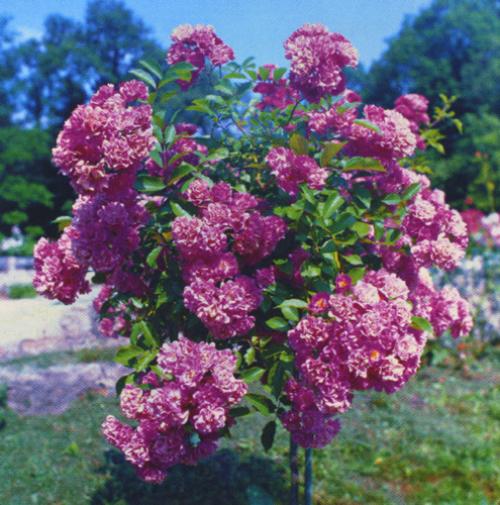

The flowers are pale pink, saucer-shaped, medium (4-4.5 cm), semi-double (18 petals), in large, dense, beautiful inflorescences (7-30). The leaves are large, shiny. Spines are rare, hooked. Vigorous bushes (up to 3.5 m). Bears fruit. Disease resistant. Winter hardy. For vertical gardening and standard culture.
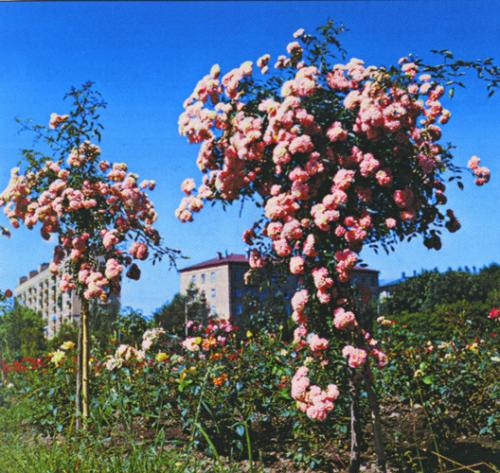

The flowers are bright pink, small (3 cm), densely double (90 petals), slightly fragrant, in inflorescences (30-40 each). The leaves are dark green, shiny. Thorns are frequent, hooked. Bushes vigorous (up to 4-5 m), with thin, flexible shoots. Flowering is very abundant, within 30-40 days, sometimes slightly repeated. Slightly affected by diseases. Winter hardy. For vertical gardening and standard culture.
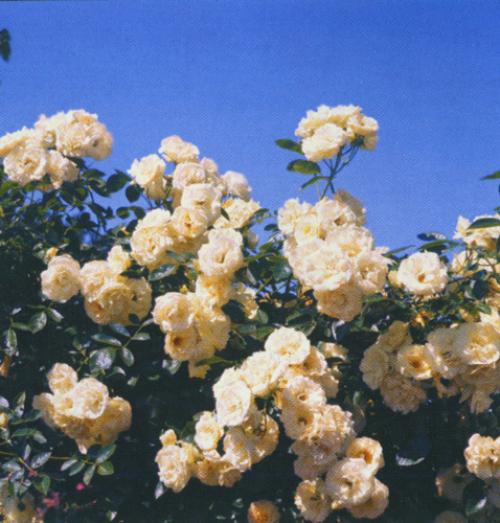

The flowers are white, loose, large (6-7 cm), semi-double (14-22 slightly corrugated petals), in inflorescences (15 or more). The leaves are large, tender. There are few thorns. The bushes are medium-sized (1.5 m), with geniculate shoots. Abundant flowering. It is affected by powdery mildew. Winter hardy. For vertical gardening and standard culture.


The flowers are pink, shiny, large (7-8 cm), double (25-35 petals), in inflorescences (3-17). The leaves are dark green, shiny, large. Bushes vigorous (up to 4 m), powerful. Abundant flowering. Bears fruit. Slightly affected by powdery mildew. Winter hardy. For vertical gardening and standard culture.


The flowers are pink to light pink, medium (5 cm), double (35 petals), with a persistent delicate aroma, in huge inflorescences (30 each). Leaves are small, medium green, shiny. Bushes vigorous, creeping, 80 cm high and up to 2 m wide. Abundant flowering. Resistant to disease. Winter-hardy. For groups, fortification of slopes, alpine slides.


The flowers are pure pink, small (3.5-4 cm), double (40-50 petals), in large, dense inflorescences (up to 30). Leaves are dark green, narrow. Thorns are frequent and large. Vigorous bushes (up to 3-4 m). The flowering is very abundant. Susceptible to powdery mildew. Winter hardy. For vertical gardening and standard culture.


In what season to plant, how to choose the soil and prepare for planting?
Before transplanting a plant to a permanent place of residence, adaptation stages should be carried out. This is necessary first of all so that the flower gets used to the surrounding atmosphere - the humidity of the room air, lighting, and other soil.If you rely on the advice on the lunar calendar, roses are transplanted for permanent residence in the fall on the growing moon.
You can speed up the adaptation period as follows - use an earthen ball, in which the root system of the flower was located when it lived in the garden. So, the likelihood of damage to the roots is significantly reduced, and the plant does not have to get used to the new, packaged soil.
Useful note: As a supplement, it is recommended to use a complex fertilizer, which is mixed in advance into the resulting overhang of three ingredients.
How to choose a bush rose pot?
The minimum diameter of the pot should not be less than the container in which the rose temporarily lived until the final transplant. The height of the walls of the pot should not be less than 7 cm. Useful note: a pot that is too deep or too large for a fragrant flower is not needed.
Preparatory stage for transplant:
- Rinse the prepared container for a rose - do not use detergents.
- Use only a brush to clean the pot.
- Soak a ceramic pot for several hours - you can overnight.
- Prepare expanded clay drainage.
If the pot was not originally provided with a drain hole, make it yourself.
Leaving immediately after planting
After a day has passed after the transplant, a new resident can be sent to the balcony (if it is warm, sunny weather outside) or to the windowsill and provide access to fresh air.
With insufficient air humidity, in addition to timely watering, it is necessary to spray rose leaves from a sprayer in order to prevent the plant from drying out or dying. It is necessary to apply fertilizers to the soil once a month. The use of mineral fertilizers will have a beneficial effect on the health of the home rose and the period of its flowering.
Features of the propagation of roses
Rose worshipers are interested in how to grow a rose from a cut from a bouquet, is it possible in principle. Yes, it is possible, but there is no guarantee of success.
Cuttings are the most popular and fastest way to reproduce this amazing beauty. But all possible methods should be considered thoroughly.
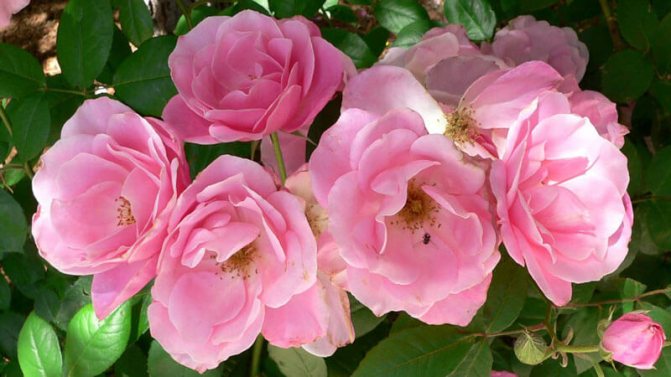

Seed propagation
The propagation of flowers by seeds takes a long time, therefore it is often used by experienced growers who know some tricks. They share instructions on how to grow a rose from seeds.
So, here it is necessary:
- The seeds can be purchased ready-made or picked from your own plantings. As soon as the rose is "fertile", it is necessary to cut it and carefully remove all the formed seeds.
- The prey is washed with a special solution, for the preparation of which a glass of water and 2 tsp are used. any bleach.
- Now you should wash the seeds and soak them for a day in a 3% peroxide solution. Only those seeds that have sunk to the bottom are used for planting.
- To accelerate the growth of future plants, the seeds are placed in a cloth moistened with peroxide or cotton pads. The workpiece is removed for 1.5-2 months in a cool room with an air temperature not higher than + 3- + 5 ° C.
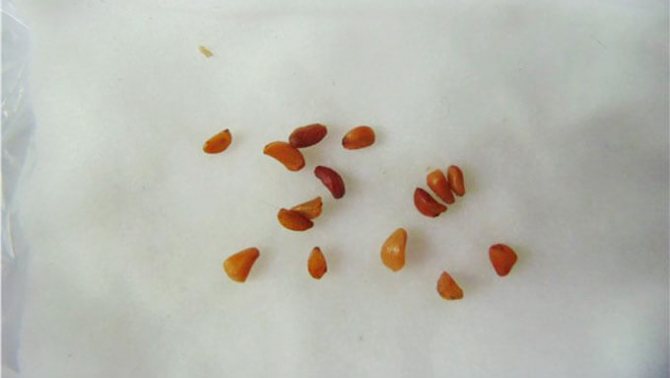

- In a month the seeds will “hatch” and they can be planted. Before planting, additional processing should be carried out in the form of sprinkling the future sowing with a special powder from root rot.
- There are no specific guidelines for sowing soil. It is enough to use a universal composition for flowers. Pour the earth into the container and deepen the seeds by 1-2 cm.
- It is better to remove the container from direct sunlight, but keep it at room temperature. As the soil dries, the roses are watered.
Sowing roses in this way will give the first shoots in 3-4 weeks. The first buds can be seen in two months. Yes, they will be medium-sized and not differ in a large number, but still.
Sowing is best done in the fall and let it grow at home until next year. And next spring, transplant it into the ground in the garden.


